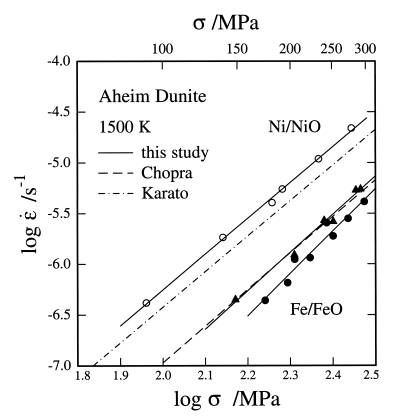

It is generally believed that the deformation behavior of olivine-dominated rocks has been well-constrained by experiment. However, uncertainties in the constitutive parameters in the mechanical flow laws translate into large errors in predicted behavior when extrapolated to the conditions of the Earth's upper mantle. In addition, experiments have generally been performed under relatively reducing conditions, near Fe/FeO, rather than under Ni/NiO conditions, which are believed to be close to those existing in the upper mantle. In fact, there has been no experimental verification that the dependencies of creep on oxygen fugacity observed in single crystals of olivine under room-pressure conditions are appropriate to high-pressure deformation of olivine aggregates. Our experiments are designed to extend the range of conditions (temperature, oxygen fugacity, strain rate) for deformation of olivine aggregates in order to provide a rigorous flow law for deformation under dry conditions.
We have performed deformation experiments on samples of natural dunite from Åheim, Norway, at 300 MPa confining pressure, 1400 to 1550 K, with the oxygen fugacity buffered by either Fe/FeO or Ni/NiO and the silica activity buffered by the presence of orthopyroxene. The samples were prepared as 10 mm cores from the same block used by Chopra and Paterson in their 1980 study, as well as from a new block of similar (though somewhat more altered) material from the same mine. Prior to deformation, all samples were heat treated at 1300 K and room pressure under controlled atmosphere conditions so that all hydrous minerals were dehydrated and the internal oxygen fugacity of the sample was preset to that of the subsequent deformation experiment.
The results of this study to date demonstrate similar absolute strengths, activation energies for creep and stress exponents for samples buffered at Fe/FeO as previously reported by Chopra and Paterson (Fig. 3.1-11). However, the results indicate somewhat greater strengths than those determined by Karato, whose data were collected only at 1573 K on samples prepared from powders of San Carlos olivine. This weakness of the finer-grained synthesized samples may reflect a small component of strain accommodation due to diffusion along grain boundaries. The experiments buffered at Ni/NiO yield considerably lower strengths under the same conditions than for the Fe/FeO-buffered samples consistent with expectations based on previous work on olivine single crystals deformed at room pressure.
 |

Tel: +49-(0) 921 55 3700 / 3766, Fax: +49-(0) 921 55 3769, E-mail: bayerisches.geoinstitut(at)uni-bayreuth.de
 Previous page
Previous page